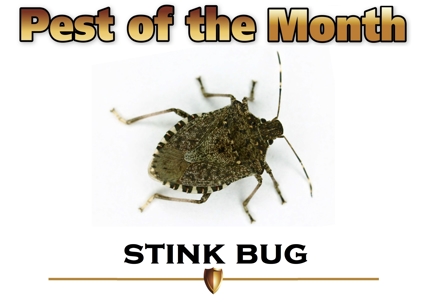It’s a brisk fall morning, and as you open the window to let in some fresh air, a strange shield-shaped insect flutters inside, only to release a pungent, unmistakable odor. If this scene feels familiar, you’re not alone. Brown marmorated stink bugs have become a common nuisance in many Providence homes, especially during seasonal changes.
Native to East Asia and first seen in the U.S. in the late 1990s, these insects have rapidly spread across the country. Their slow, careful crawl and tendency to gather on windows or walls may seem harmless until they get inside.
Understanding how stink bugs behave outdoors, what attracts them into homes, and how to deter them is the first step in keeping pests out of your home. At Guardian Pest Control, our exterminators offer effective pest solutions to give you peace of mind.
If you’ve spotted stink bugs in your home or want to avoid a possible infestation, contact us at (401) 812-3033 for professional advice and support.
Life in the Garden: Where Stink Bugs Thrive Before Entering Homes
Brown marmorated stink bugs (BMSBs) begin their seasonal activity in gardens, yards, and fields. Originally from Asia, they were unintentionally introduced to the United States in the late 1990s and have become a widespread agricultural pest. These bugs are especially drawn to home gardens, fruit trees, and ornamental plants.
During the warmer months, stink bugs feed on over 100 plant species, including popular favorites like tomatoes, beans, cucumbers, apples, peaches, and pears. Their piercing mouthparts allow them to suck juices from fruits and vegetables, causing blemishes and making them less appealing or unusable. While this doesn’t pose a health risk, it can frustrate home gardeners.
Females typically lay clusters of pale green eggs on the underside of leaves in late spring and early summer. These eggs hatch into nymphs that go through several developmental stages before becoming adults by late summer or early fall. Despite being prolific breeders, stink bugs remain outdoors for most of their life cycle until the weather starts to change.
Although they have few natural predators, such as parasitic wasps and some birds, these are often insufficient to control their population. This allows BMSBs to thrive in urban gardens and rural farmland, increasing the likelihood of getting inside.
Why Stink Bugs Move into Your Home
As autumn arrives and temperatures drop, stink bugs go into survival mode. Shorter daylight hours and cooler air act as biological signals, prompting the bugs to seek a warm, protected place to overwinter. Your home becomes important here.
Stink bugs enter diapause—a type of insect hibernation—where they remain dormant during winter. In diapause, they don't eat, breed, or grow. Their main goal is to find shelter until spring, and unfortunately, many homes in Providence offer the perfect refuge.
Although light may attract a few stink bugs, warmth and shelter are what draw them indoors. Homes provide an ideal environment with stable temperatures and many small cracks and entry points. Common access points include gaps around windows and doors, attic vents, siding seams, chimney openings, and utility line gaps.
Once inside, stink bugs gather in quiet, undisturbed areas. You might not notice them until a sunny winter day causes them to emerge and wander into living spaces, often by the dozens.
What Stink Bugs Do Inside Your Home
Once inside, stink bugs are more of a nuisance than a threat. You’ll usually find them in attics, basements, wall voids, crawl spaces, or behind baseboards—anywhere dark and undisturbed. While their sudden appearance in the middle of winter can be startling, their behavior is mostly passive.
It’s important to know that stink bugs do not reproduce, feed, or cause structural damage when indoors. Their presence is only for shelter, and their activity inside is usually limited and occasional.
However, their unique defense mechanism makes them especially unpleasant: when threatened or squished, they release a foul-smelling chemical from glands on their thorax and abdomen. This smell can linger and is hard to get rid of, so squishing them is not an ideal way to remove them.
Keeping Stink Bugs Out: Prevention Starts Before They Get Inside
Preventing stink bug invasions starts with thorough exclusion and upkeep around your home and garden. While complete prevention can be tough, you can implement several practical measures.
Seal entry points:
- Inspect your home’s exterior for cracks and gaps around windows, doors, foundations, and siding.
- Use weatherproof sealants and install door sweeps.
- Repair damaged screens and make sure attic and vent screens are secure.
- Check around utility entry points and seal any openings.
Garden and exterior maintenance:
- Remove garden debris and weeds, especially near your home’s foundation.
- Minimize exterior lighting near entrances or switch to yellow bulbs, which are less attractive to insects.
- Hand-remove stink bugs from garden plants when possible.
While DIY methods are helpful, stink bug populations can be persistent, especially in heavily wooded or farmed areas around Providence. Professional pest control may be required for more effective management and prevention.
You Don’t Have to Handle Stink Bugs Alone
Understanding the seasonal behavior of brown marmorated stink bugs is essential for safeguarding your home and garden. These pests exhibit a predictable pattern, from their outdoor feeding habits to their winter hiding spots. With the proper knowledge and prevention strategies, you can stay ahead of them.
If you’re dealing with a recurring stink bug issue or need assistance sealing your home, Guardian Pest Control can help. Our team of licensed exterminators employs advanced techniques and products designed to prevent infestations and keep your home comfortable all year.
Contact us at (401) 812-3033 to learn more about stink bug prevention or to schedule a home assessment.

